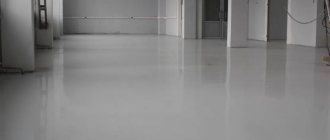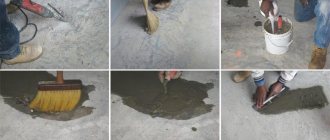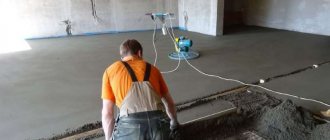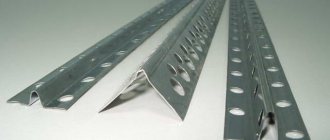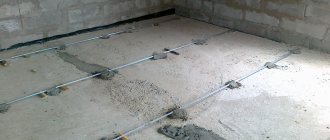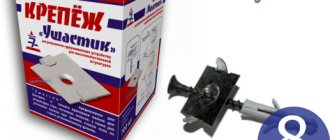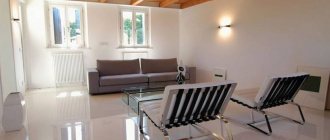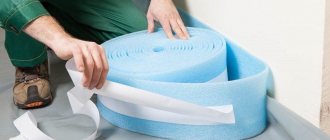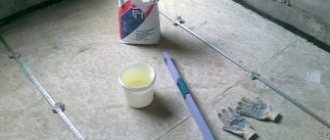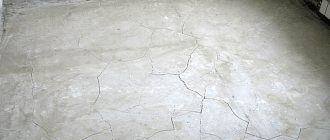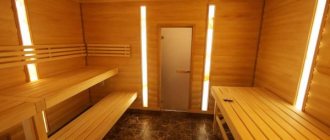Often new buildings are delivered with rough repairs and on the floor we see floor slabs with broken heating pipes. The whole thing is covered with a floor screed: classic (concrete mixture) or semi-dry (using a relatively new technology). But few fully understand what it is.
Composition of semi-dry solution
The basis of the semi-dry mortar is sand, cement and water.
This is the base from which floor leveling can be done in many cases. Fiber fiber, various additives and plasticizers are not primary in the composition. Their absence in certain cases is not critical. And, to be honest, you shouldn’t bother yourself with them. Imagine - an ordinary screed in ordinary new buildings - what kind of fiber? - maximum plasticizer (not a fact). And will this make the screed worse for ordinary household use? Of course not. Another issue is the additional financial costs and the need for use. If you can afford it, then using additional components is somewhat acceptable. And only in those cases where it is necessary. Let's look at the main (and not so basic) components that make up a semi-dry floor screed:
- The basis of the foundation is cement. The brand of cement is not so important. The main thing is to maintain the proportions for a specific brand of solution. The higher the grade of cement, the less it will be required in volumetric terms.
- Sand without impurities. To prepare construction powder, quartz, river or construction sand with a fraction of no more than 3 mm can be used. Sand of larger fractions is not desirable with the semi-dry method.
- Water.
- Fiber fiber. Polypropylene fiber acts as a reinforcing mesh, which gives the layer special strength and resistance to mechanical stress. The use of additional components has already been mentioned above. However, I would like to once again dwell on the absurdity of some information, which, unfortunately, is at the top and publicly available. Here is one of the gems: “But, unlike a metal frame, fiberglass is not subject to corrosion and destruction.” Essentially, high-quality (non-rusted reinforcement) placed in mortar or concrete, if used correctly, will outlive the great-grandchildren of the “great” construction experts.
- Plasticizer for semi-dry floor screed. Plasticizers are modifiers for concrete and mortar mixtures designed to increase the fluidity and workability of the mixture. As a rule, these additives are used to reduce the water-cement ratio, as well as for self-compaction of concrete and mortar mixtures.
How to determine how much a cube of sand weighs: material characteristics
Many owners of country houses try to calculate the weight of sand in one cube. This indicator is especially relevant for suburban construction, which involves such serious amounts of work as the construction of a building or the arrangement of a yard and local area. How much does 1 cubic meter of sand cost with delivery is one of the burning questions of any person who undertakes independent construction or is concerned about purchasing material for hired workers.
Depending on how many kilograms of sand are in a cube, the main proportions of the concrete mixture will be calculated. This point is very important, since an incorrect calculation will lead to disruption of the technology and serious consequences.
Sand is used for a wide range of construction work
Why is it so important to determine how many cubes of sand are in 1 ton
An indicator that reflects how many kilograms are in 1 cubic meter of sand can cause many difficulties if calculated incorrectly:
- violation of the concrete mixture recipe;
- incorrect consistency of the finished solution;
- loss of adhesive properties;
- low quality concrete;
- disturbances in the hardening process;
- reduction in concrete strength;
- premature destruction of a structure made of cement mortar.
Calculation of the amount of material and proportions
There are two types of mixtures used in construction: regular and ready-made. Conventional mortar is used to level not only the floor, but also to level the walls. The simplest standard solution of self-leveling floor screed is prepared using M300 grade cement and clean sand, which has a medium-grained fraction. The third component is water.
All components are mixed as follows: take 1 part of cement and add 1.5 - 3 parts of medium-grained sand. But the amount of water is calculated based on how many kilograms of cement were taken. For 1 kg of cement take 0.5 liters of water.
Now on the construction market there are a lot of modifiers and fillers that are added to the sand-cement mixture. Why do they do this? To increase frost resistance, reduce the time for hardening, and also reduce the likelihood of cracks and delamination.
Conventional mortars, like backfill for dry floors, are sold on construction markets. Their use will reduce the time spent on repairs. In such mixtures, all components are ideally selected and in ideal proportions. The manufacturer produces each type for one or another type of connection to the floor.
The video shows the consumption of PCB per 1 m2 of screed:
The weight depends on the proportion of the components that are included in the composition: on the amount of water, on the power of the screed and on the brand of cement used. The maximum thickness of the screed usually does not exceed 7 cm, otherwise the foundation of the house will have to be strengthened so that it can withstand such a large load. Depending on the thickness of the layer, choose the type of bond:
- the screed will be connected to the rough foundation and to the walls;
- will not be associated with any structures;
- an insulating layer is used, as a result it will be a floating layer.
What is a cement-sand screed?
This screed is a mixture of cement and sand into which special substances are mixed. You can prepare this mixture yourself - purchase the necessary components, or purchase ready-made mixtures in the store. Ready-made mixtures are available in two types: dry, which are kneaded, and wet, which are ready for use.
Homemade mixture
If we are talking about the first floor, then the use of homemade mixtures is acceptable, but starting from the second floor, store-bought ones have a clear advantage. This is explained by the fact that ready-made mixtures have a fixed weight and improving additives, which cannot be guaranteed when preparing the mixture by eye.
Classification of screeds.
According to the method of adhesion to the floor, there are the following *types and types of screeds*:
- Related to the base;
- On the separating layer;
- On an insulating layer (“floating”).
Rice. 1. Types of screeds according to the method of adhesion to the floor
Tied ties are those that are tightly coupled to the base. In other words, there are no separating layers between the base and the screed. This type of screed can withstand heavy loads, but the shrinkage of tied screeds is uneven and can often result in cracks. And the humidity of such screeds depends on how saturated the ceiling is with moisture. The use of screeds on the separating layer will help prevent the screed from adhesion to the ceiling. The role of the separating layer is usually performed by the following materials:
- Bituminous paper;
- Oiled paper (glassine, roofing felt);
- Polyethylene films.
In order for such a screed to be strong enough, its thickness should be at least 30 mm. If special waterproofing is required, then a screed is applied to the separating layer.
“Floating” screeds on the insulating layer are not connected to the base. This is an independent building structure. The layer - bedding between the floor concrete and the “floating” screed is made of the following heat and sound insulating materials:
- Stone wool;
- Mineral wool;
- Foamed polystyrene;
- Cork board;
- Fiberboard.
The smallest thickness of a “floating” screed is 50 mm. The use of screed on the insulating layer increases the thermal and sound insulation of the floor. In addition, the moisture contained in the screed will not depend in any way on the concrete floor. But this design scheme has low compressive strength and also has increased thickness. In this type of screed, in most cases it is necessary to additionally reinforce the top layer.
Rice. 2. Reinforced screed
Prefabricated screeds are elements that are ready for installation and are designed to be connected with seams. Installation is made from large-sized sheets, as well as slabs - plywood, chipboard, fiberboard, gypsum fiber (GVL) sheets. The elements of prefabricated screeds are not heavy, so even one person can easily install them. There are no “wet” processes when working with prefabricated screeds, which makes it possible to lay face coverings immediately after installation. It should be noted that prefabricated screeds cannot be used for every face covering.
Rice. 3. Dry screed diagram
Types of polystyrene concrete screeds
I can distinguish two main types of polystyrene concrete screeds - thermal insulation and structural-thermal insulation. In the first case, mixtures with lower density and lower thermal conductivity are used. They are very effective as insulation, but at the same time withstand less load.
For screeds, it is better to abandon this option. In the second case, a denser mixture of up to 600 kg per cubic meter will be required, which will withstand higher loads. I consider the optimal density for arranging screeds to be 400 kg per cubic meter. Such a screed with high strength characteristics will provide excellent thermal insulation and sound insulation.
Strength or thermal insulation properties?
.
Varieties: cement screed
- Messenger
. Typically used in high-rise buildings - the DSP here serves to level the floor slabs. To create a reliable base, you need good adhesion - connection - between the poured layer and the old one. That’s why the type of screed is called – connected. Its minimum layer is 3 cm. - Incoherent
. With this type of base, the new layer is not bonded to the old floor. For example, installation on a concrete base that has been previously polished or on a layer of insulating material. The minimum thickness of the screed is 5 cm. - Floating
. If the floor needs to be made warm, it is impossible to achieve a rigid adhesion of the screed to the base. When the insulating material changes its dimensions, the concrete layer placed above also lowers/raises. That’s why this screed is called floating. To create rigidity, which requires a minimum thickness of the cement-sand mass in this version of the screed, at least 6.5 cm.
All of these types of CPS have their own installation characteristics, but they are united by the use of sand-cement mortars. Sometimes, to increase reliability, reinforced fibers are added to the composition. This is usually fiberglass; there are additives from small parts of steel wire, but they are not used often. Reinforcement of the solution is required when the concrete layer is large.
According to building rules, the minimum thickness of the screed is 3 cm. With the thinnest layer during the period when the mortar dries, the canvas will crack and the base will be unreliable. At the same time, concrete has a lot of weight: per 1 m2, a 10 mm layer weighs approximately 20 kg. And since the minimum thickness is 3 cm, then the minimum weight of 1 m2 of screed will be 60 kilos. Not every foundation is capable of supporting such a load without consequences. This can cause the foundation to shrink and crack. To reduce the weight of the screed, light binders, for example, expanded clay, are included in the solution. The mass of 1 cm of expanded clay concrete is 16 kilos. With volumetric footage being poured, the difference is significant.
Semi-dry floor screed price per square meter with materials
If you decide to hire workers, then with mechanized work such pleasure will cost you from 400 to 59,600 rubles. But the price is determined by two parameters: the cost of work and materials.
Let's look at this using a simple example: to lay a screed 60 mm thick per 1 m2 you will need 3 pawns of sand concrete. The cost of such products will be 200-220 rubles.
Thus, to screed 1 m2 you need to spend 600-700 rubles. In addition, you also need to purchase fiber, which comes out to 20 rubles per m2.
This is an excellent option for obtaining a durable, smooth and high-quality floor. Now you don’t need to spend money on expensive mixtures or wait until the concrete mixture has dried.
Mixture preparation and consumption
To obtain a mortar for grade 150 screed, you need to mix cement (M400) with clean, washed and sifted sand without foreign inclusions (usually clay) in a ratio of 1:3, in other words, for 1 shovel of cement and 3 shovels of sand. These proportions are always indicated on the packaging of a specific brand of cement. If necessary, plasticizers and other additives are added. The resulting mixture is thoroughly mixed and adjusted with water to the required consistency.
Semi-dry screed technology eliminates shrinkage, deformation, and the appearance of cracks. To visually check the compliance of the technology, the prepared solution can be squeezed tightly in your hand and not a drop of water should come out of it.
When adding fiber, the following proportion must be observed: per 1 cubic meter of solution there should be at least 600 grams of polypropylene fiber.
In the question of screed consumption and calculation of the necessary components, we turn to the table of cement consumption per cubic meter of solution:
| Maka cement | Brand of solution | Cement consumption per 1 m³ of solution |
| M400 | M200 | 490 kg. |
| M500 | M200 | 410 kg. |
| M400 | M150 | 400 kg. |
| M500 | M150 | 330 kg. |
Let's calculate the required composition of semi-dry screed for a room with an area of 20 square meters. We will use cement (M500). The cement/sand proportion for mortar grade 150 is 1/4, respectively. The thickness of the screed is 4 cm or 0.04 m (minimum permissible value).
Calculation:
- 20 (sq.m.) * 0.04 (m.) = 0.8 cubic meters of mixture is required.
- From the table above, the consumption of cement (M500) per cubic meter of solution (M150) is 330 kg.
- We make up the proportion: x/0.8 = 330/1; where x is the required cement consumption for a volume of 0.8 cubic meters. mixtures. Accordingly, the required amount of cement (x) = 330 * 0.8 = 264 kg.
- Based on the proportion of 1/4, sand will be required - 264 * 4 = 1056 kg.
This calculation will allow you to calculate with a certain degree of accuracy all the components that you will need for the screed.
Classification by weight
The use of concrete mass has become quite widespread: from finishing purposes to the construction of dams. That is why the characteristics of the mixture are displayed by dividing them into classes and brands. This makes it possible to make precise choices for specific purposes. For example, B25 grade of concrete is much stronger than B10 and, naturally, its mass will be greater. There is also a division depending on mass. The table will help you see exactly the weight of concrete in 1m3, but more on that a little later, but for now let’s look at the division by “weight categories”:
| specific gravity, kg | ||
| especially light | M50 - M75 | up to 500 |
| lungs | M100 - M200 | 500-1800 |
| heavy | M200 – M400 | 1800-2500 |
| especially heavy | M 450 and above | 2500-3000 |
Weight directly depends on the density of all elements and can be in the range of 300-3000 kg.
Thermal insulation (extra light)
This material is made from cement and fillers, which when mixed, produces a structure with about 85% voids. Used for the manufacture of structures with special requirements for thermal conductivity (they are not able to withstand significant load-bearing loads). This category includes mixtures weighing up to 500 kg per cubic meter. In some cases, a plasticizer for concrete is used to increase their strength.
It is worth considering the low resistance of porous structures to frost. When installing them, it is necessary to install waterproofing protection.
Easy
This is how a solution with a mass in the range of 500-1800 kg is classified. It is mainly used to create special building blocks, the structure of which contains pores - they can be formed with the help of foaming agents or due to the use of cellular fillers (expanded clay, for example).
Only ready-mixed concrete can exactly match the specified weight and grade.
Heavy
Heavy concrete is one of the most common in construction. It is ideal for the construction of structural components that perform a load-bearing function. The weight of the cube in this case can be 1800-2500 kg - this figure depends entirely on the percentage of sand and coarse filler, as well as the density of the latter (even when using granite and gravel filler in the same quantity, the final weight of one cubic meter will be different).
Super heavy (extra heavy)
For its manufacture, metal fillers are used, which increases the weight characteristics to a maximum limit of 1 cubic meter - a little more than 3000 kg. Such mixtures are used to prevent the spread of radioactive radiation through walls.
The production of super-heavy mixtures involves the use of materials quite specific to construction, the cost of which will make the construction of a house quite expensive. That is why they are used exclusively in the construction of objects with increased requirements for radiation protection.
Advantages and disadvantages of semi-dry screed
The choice in favor of this technology is justified by a number of its advantages, which did not go unnoticed by builders of all levels.
Semi-dry screed has the following advantages:
- A small amount of water added to the mixture. Its penetration into the ceiling is almost completely eliminated. A reduction in the weight of the poured material is achieved.
- Reduced setting and complete drying time. Ability to continue working without a long break.
- Creating a perfectly flat surface at the formation stage without the use of self-leveling solutions and additional leveling.
- Minimizing the likelihood of cracks and shrinkage after curing of the solution. No risk of internal voids forming.
This method also has disadvantages:
- Impossibility to do without special equipment. It is necessary at the stages of preparation, distribution and compaction of the mixture.
- Difficulty filling internal corners. You have to spend time and effort on this, sealing such places manually.
- Restriction on the minimum thickness of the slab. It is 30 mm, provided compaction is carried out with a powerful pneumatic spreader.
- Fast setting. On the one hand, this is a plus, and on the other, a minus, since the solution can harden without sticking to the base.
Extra lightweight concrete
This group includes solutions with a specific gravity of up to 500 kg/m3. Such solutions have a porous base and air cells with a diameter of up to 1.5 mm.
They are used to create gas and foam blocks. In addition to the traditional ingredients - sand and cement - their formulation includes special foaming additives that promote the formation of air cavities.
Products made from such concrete are characterized by low weight and increased heat-saving ability. For their production, mixtures of grades M50-M75 are used.
Lungs
These are concretes with a specific gravity in the range of 1000-1800 kg/m3. In such mixtures, a porous material such as expanded clay is used as a filler, or foaming agents are included in their composition, increasing the porosity of the structure.
These compositions are also used for the manufacture of building blocks. Lightweight concrete includes building mixtures marked M100-M200.
Heavy or classic
This category includes building mixtures with a specific gravity in the range of 1800 - 2500 kg/m3.
They are most in demand for most construction operations. Their:
used for arranging floor screed;
The composition of such mortars includes coarse sand, crushed stone or gravel. It is the fillers that make up the bulk of the volume of the solution and determine its weight. Solutions marked within the M200-M400 range are considered heavy.
Handmade cement floor screed in a bathhouse
To level the floor slabs, use a tie screed. In apartment premises, the floors between floors are usually made of reinforced concrete slabs. This sand-cement screed is also suitable for a bathhouse building on a slab foundation. But only when waterproofing and insulation are not needed.
This type of screed is also suitable for
:
- Porches;
- Tambura;
- Verandas, etc.
The main task of preparation in this case is to create the best possible adhesion of the concrete layer to the base. To do this, you need to very well clean the surface of debris and dust. It is better to do this by using a vacuum cleaner - a brush cannot remove all the dust. There is no need to level out uneven areas; on the contrary, if there are smooth areas, it is necessary to make grooves/pits in them. Correctly seal only very deep cracks, and do not even out the surface. After all dirt has been removed, the surface is generously primed.
The primer must be allowed to dry for at least 8 hours; drying time depends on the humidity and temperature conditions in the room. After drying, you can install the beacons and pour the mixture (cement, sand) with your own hands. In order to prevent the destruction of the screed or vertical surfaces due to different amounts of expansion when changing temperature conditions (different densities), a damper tape must be installed around the perimeter of the room. This especially plays a role when the vertical surfaces are wood, which is almost the rule in bathhouses.
The tape must be rolled out and attached to the walls. It is usually larger in height than the screed, but when the cement sets, it must be cut to the level of the floor. If waterproofing of the DSP is required, it will no longer be cohesive. Here the preparation is different. Waterproofing material is placed on a clean and flat surface. If the base is uneven, for example, the surface of the foundation slabs in a bathhouse, then it must be leveled. For this purpose, the leveling connection DSP described above is used.
After drying it, you need to lay out the waterproofing and pour another layer of concrete (a special tape will also be required). Due to the fact that the base does not absorb moisture during such installation, cavities and pores may appear. Therefore, the solution must be processed with a vibrator. By increasing the thickness of the floor surface screed to 100 mm, the problem resolves itself, but the costs and weight are greater.
It is important that the filling technology is followed
Caring for semi-dry floor screed after pouring
After the coating is laid, it must be covered with film so that it does not dry out too quickly. To ripen the cement stone, it is necessary to provide humidity conditions for 24 hours with a screed thickness of 5 cm.
After just 4 days, you can lay decorative flooring: from linoleum to parquet boards and vinyl tiles. After completing such a screed, any material will fit perfectly onto the leveled floors.
Caring for a semi-dry screed is required only in the first week and consists of not allowing it to dry out during the first few days after completion of work.
Ideally, for the first few days, water the surface at the rate of 1 liter of water per 2-4 square meters. meter of screed. Under no circumstances should you create a draft in the room during the first 3 days. If possible. It is better to cover the wet surface with P/E film, this will promote complete hydration of the cement and will significantly improve the quality of the floor.
Types of concrete screed
With reinforcing mesh
Concrete screed is used most often. To construct it, a metal mesh is used, which is covered with 4-5 cm cells. Low supports are installed throughout the floor and the mesh is laid on them. This increases strength and wear resistance. Among the disadvantages of use it should be noted:
- due to the metal's susceptibility to corrosion, the mesh will gradually deteriorate, the concrete screed may delaminate, which adversely affects the service properties. This process takes many years, so the prevalence of the method has not decreased;
- cracks may form.
Fiber screed
Due to the constant development of construction technologies, fiberglass has recently begun to be used in laying concrete screeds. It is placed in a concrete solution instead of a reinforced mesh. It is a thin synthetic substance - microfiber made from polymer granules.
By making concrete more flexible, fiber fiber adds resistance to cracks. The advantage is that the use of such material is easier and more economical than metal mesh by 6 times per m2. In addition, do not forget about such a plus as the effect of reinforcement. The disadvantages include strict adherence to proportions and calculations when using the material. A mistake will turn the concrete into crumbs.
What is the density (specific gravity, volumetric weight) of cement-sand screed kg m3
Many technologies and materials are used to install floors and floor coverings, the choice of which depends on the purpose and operating conditions of the room or facility. The universal materials for performing this type of work are cement-sand mortars and concrete.
When choosing, you should take into account the various characteristics of the material for leveling, one of which is the density of the cement-sand screed in kg/m3. This indicator determines the total weight of the screed and the load on the base of the foundation or interfloor ceilings, exceeding which can lead to a decrease in the overall reliability of the building.
Features of working with different types of screeds.
Different types and types of screeds imply individual characteristics of their installation.
Manufacturers of screeds indicate the degree of strength of the coating in the instructions for their products. But the manufacturer does not do the installation itself, so the warranty only applies to the material. As a result, the packaging often overstates the strength of the original screed. There is a conflict of interest. The manufacturer is interested in having the material he produces laid on a super-hard screed; the buyer wants to buy a quality product at an affordable price. If the buyer fulfills the requirements of the flooring manufacturer and makes the screed with a strength of up to 300–400 kg/cm², he will retain the warranty. If he does everything according to the requirements of SNiP, then he can be sure that everything was done correctly and reliably. The conditions of SNiP 2.03.13-88 “Floors” are as follows:
1) The strength of the screed based on cement binder for all types of floor coverings should not be less than 150 kg/cm²;
2) If it is necessary to level the screed with self-leveling mixtures - at least 200 kg/cm²;
3) The strength of gypsum screed for all types of floor coverings should not be lower than 100 kg/cm²;
4) For polymer “self-leveling” - no less than 200 kg/cm².
The screed for self-leveling mixtures is usually made the strongest, because the “self-leveling” mixture sets the fastest, which contributes to the development of high internal stress. There will be no cracks, but a weak bottom tie may be “pulled” and torn from the base.
You also need to take into account that a complete replacement or installation of a new screed will put all its weight on the reinforced concrete floor slabs. Reinforced concrete floors in old houses have limitations on load-bearing capacity, which is equal to 400 kg/m² - permanent load and plus 150 kg/m² - temporary load. For example, every centimeter of a screed with a volumetric weight of 1800 kg/m³ will press on the ceiling with a weight of 18 kg/m². If the screed is 5 cm thick, then each square meter of flooring will receive a load of 90 kg. These figures prove that such a screed will take 25% of the entire load-bearing capacity of the floor.
If it is necessary to increase the thickness of the screed or replace the screed material with one that is heavier, everything will have to be coordinated with the load-bearing capacity of the floor, and therefore approved by local authorities.
Old house, the floors were wooden, we removed the joists and boards, we want to fill the screed.
It turns out you need a thickness of 10 cm, perhaps even more.
Is it possible to pour screed of this thickness in an apartment?
The decision is made individually, the following points are taken into account:
What kind of floor slabs are installed in your house, for example, these
But there are floor slabs with a permissible load of 800 kg or more per sq.m.
The age of the house, it is advisable to conduct a construction examination in order to know exactly the permissible load on the floor slab; the older the house, the lower this figure.
Screed weight, cement-sand screed weighs on average 220 kg sq.m.
The weight of the finishing floor covering, for example, tiles with glue, weighs much more than linoleum or carpet.
The weight of the furniture (this is a constant load).
The weight of the users living in the apartment (not a constant load, but it must also be taken into account).
Next, the floor slab is affected not only by your screed, but also by the weight of the ceiling plaster of the neighbors below.
That is, go down to your neighbors and determine how they repaired the ceiling.
The presence of partitions 9 in the same room (this is also a load on the floor slab), if there is a partition, then what kind, for example, a partition made of brick weighs much more than a partition made of gypsum board.
Further, when raising the floor by 10 cm, problems may arise with the heating radiators, or more precisely with the distance from the floor to the radiator; they will have to be raised higher.
Reinstall interior doors, otherwise the door leaf will touch the tie when opening.
Taking all this into account, a decision is made.
If we are talking about a house from an old housing stock, then most often there were joists on the floors and then a floorboard; here you can do without reinstalling the doors and raising the radiators higher; the boards were removed, the joists were removed and the screed was poured.
If the load on the floor slab is acceptable, then in principle it is possible to pour a 10 cm thick screed in the apartment.
Screeds of this thickness are reinforced and do not forget about waterproofing under the screed and installing a damper tape around the perimeter of the room before pouring it.
Before laying the final floor covering, the screed must be completely dry and gain maximum strength.
PROFESSIONAL CONSTRUCTION OF CEMENT SEMI-DRY FLOOR SCREED WITH FIBER – EXPERIENCE SINCE 2002
•When laying various communications on the floor, with very uneven floors, the thickness of the screed is especially large. Achieving an ideal surface can be very difficult, and German technology for the production of semi-dry screeds with fiber fiber has recently been brought in to help builders. Using the technology of laying semi-dry screed, the customer receives the following advantages.
•Firstly, the result of the work is a perfectly flat base, which is completely ready for laying parquet, linoleum, cork, etc. The use of a trowel during screed production eliminates the formation of voids and cracks on the surface of the screed.
•Secondly, the production of screed using this technology significantly speeds up the floor production process. It is possible to lay up to 250 m2 of screed per shift. After twelve hours, people can walk on the floor, and after four days the floor is completely ready for laying the finishing coating. And all this thanks to the minimal amount of water in the sand-cement mortar.
•Thirdly, in the production of mortar and its installation, it is possible to use various modern construction equipment from concrete pumps to pneumatic blowers. And the quality and composition of the solution allows it to be supplied to a height of up to eighty meters and a distance of up to one hundred and fifty meters.
•And fourthly, the production costs of this type of screed are very competitive. And all thanks to the low cost of materials used in production and the cost of work . Cement, sand, fiberglass for reinforcement are all much cheaper than leveling polymer mixtures and steel mesh or reinforcement.
Having shown all the advantages of semi-dry screed, it’s probably worth dwelling on the process of laying it. After all, most of the advantages are achieved by impeccably following production technology.
The impact resistance of a cement floor (according to SNiP 2.03.13-88) is characterized by the absence of chips when an object weighing up to 3 kg falls from a height of 1 m. The listed properties allow the use of cement-sand compositions for the installation of continuous floor screeds in residential, industrial, warehouse, retail, office premises on all floors, flat roofs, etc. In addition to cement (Portland cement is usually used) and fine-grained quartz sand or gravel, various special fillers (fiber fiber) and modifiers (plasticizers, shrinkage and hardening regulators, etc.) are added to the cement-sand mixture. Fiber reinforcement of a cement-sand screed allows you to avoid the costs associated with traditional reinforcement of a cement floor with steel reinforcement. Modifying additives change the physicochemical properties of the cement material and increase its plasticity (with a decrease in the amount of water in the solution), frost resistance, and corrosion resistance.
When plasticizers are introduced into a cement-sand mixture, the delamination and water separation of the cement mortar decreases, the rate of hydration and setting of cement in the initial stage of hardening decreases, which contributes to the formation of a more uniform and fine-grained structure of the cement coating.
Cement-sand screeds based on modified Portland cement can be used as waterproofing and anti-corrosion protective layers for reinforced concrete foundations. The thickness of the cement-sand screed layer depends on several factors: the degree of unevenness of the base, the type of floor covering, and the presence of an insulating layer. In particular, the screed made from a mixture with plasticizing additives must have a thickness of at least 4 cm; water heated floor and screed with plasticizer on top of the floor heating system - at least 5 cm.
Laying cement-sand screed over large areas is usually carried out with specialized units (for example, TURBOSOL, PUTZMEISTER mortar pumps), which can significantly reduce labor costs and work time. The poured cement mortar is leveled and compacted; When the cement gains primary strength, the surface is smoothed with trowels and expansion joints are made.
When laying a monolithic cement screed over an area of more than 40 sq.m. immediately after grouting the surface, it is recommended to cut expansion (shrinkage) joints to prevent the appearance of cracks. The seams are cut into squares with a side of 2.5 m and to a depth of 1/3 of the layer thickness. The time for complete drying and strength gain of a screed based on conventional unmodified cement ranges from 25-30 days, depending on temperature and humidity, about a month.
Expansion, expansion joint in the screed.
When installing industrial floors based on cement-sand screed without the use of floor coverings, the surface is ground, impregnated with foam-filling compounds and antistatic agents, coated with polymer varnishes and paints to reduce dust separation and give the cement floor increased strength characteristics and decorativeness.
In this regard, we believe that it would be useful to know how the most modern and most technologically advanced types of screeds currently existing - cement-sand screed with fiberglass - are installed.
Properties of the screed: Acoustics It is necessary to choose a floor structure that will not allow sound to pass and spread throughout the structure. That is, the floor should dampen the sounds of the room well. Protection from airborne noise (conversations, screams; various collisions of objects in the air, for example, a child knocking on a drum), protection from impact noise (steps on the floor, objects and residents falling on the floor) and protection from combined noise (music playing in the speaker system , working home appliances) are extremely necessary. Almost everyone is familiar with the sounds when (especially) neighbors (above) “walk right on their heads.” Of course, if neighbors make noise on purpose and demonstratively, then it will be difficult to protect your ears and nerves from them and it will be cheaper to deal with such neighbors than to create an entire soundproofing system. But when a normal household noise level is created, it is necessary to reduce this noise as much as possible and leave it in the room where it originates, so that the neighbors do not “deal with” you.
There are three ways to minimize noise:
1. Eliminate the source of formation 2. Absorb sound 3. Decouple the structure with materials that prevent sound transmission
Eliminating the source of sound is a purely psychological aspect of solving the problem. Asking your neighbors to shut up and turning down the volume on your home equipment does not always bring results. And since in the process of one’s own repairs and decoration, one’s own life activity is decided first of all (it is impossible to refuse the pleasures in the bedroom, it is impossible to remain silent with household members, and there are also one’s own secrets about work, raising children and husband/wife, which neighbors and wives do not need to know about). sometimes you also want to listen louder to the latest news and hit parade), then the contribution to sound insulation is partially solved with the help of the screed design (you, too, will not be persuaded to shut up forever and not walk on the floor?). Therefore, you have two ways (2 and 3 methods) of deciding to turn down the volume of your behavior for your neighbors.
Sound absorption – low-density porous materials, primarily fibrous and fleecy materials, absorb sound best. Of all floor coverings, carpeting absorbs sound best. But a carpet on the floor will not protect against a heavy object falling on the floor, although it does a good job of muffling the noise from feet shuffling across it.
Decoupling the structure is the most popular method. If the sound originated in the room and was transformed from the air into the floor covering or screed, then the resulting vibrations must be prevented from “walking” further along dense structures. For decoupling, materials of different densities and various low-density gaskets are used to prevent dense materials from coming into contact with each other. So, for example, almost any thickness of polystyrene foam, polyethylene foam or mineral wool under a massive concrete screed can delay the spread of a significant part of the resulting noise - in this design, the difference in the densities of the materials is very large and the concrete screed, using a low-density porous gasket, isolates the transmission of vibration from the concrete screed to the concrete ceilings The construction of gaskets made of polyethylene film, roofing felt, glassine, etc. is worse to “untie”, since they are thin, non-porous and do not create the maximum difference in the density of materials.
If improved sound insulation is required, then it is necessary to combine both decoupling and absorption in the screed. Mineral wool absorbs sound better, so in this design it is used primarily, and the thicker the mineral wool , the better the sound insulation. For more effective sound absorption, it is necessary to have a layer of low-density mineral wool, which practically makes it difficult to construct a screed, because it is impossible to make a concrete screed with low-density mineral wool, so either a conditionally “ideal” screed is made from a thick layer of low-density mineral wool in a wooden sheathing installed on pads made of foamed polyethylene under the joists, a thick layer of dense mineral wool is placed on top of the sheathing and a cement-sand screed is made, or a DSP screed using one layer of dense insulation, the acoustic sound insulation of which is sufficient, because in addition to the screed, the sound will spread along the walls (therefore, when With an “ideal” soundproofing screed, sound will still pass through, but through different structures).
Do-it-yourself semi-dry screed step-by-step instructions
The entire scope of preparatory work does not take much time and consists of preparing the base for the screed and preparing the working solution.
The coating is carried out on a completely cleaned surface. In addition, it is necessary to carefully eliminate all chips in the base and deep cracks. All delaminations in the base require cleaning followed by puttying. After all work completed, a zero level mark is set.
- All work can be described in the form of step-by-step instructions:
- Preparation of working solution
- If you plan to use fiberglass, then a mixture of sand, fiberglass and cement must be poured into the pneumatic hose blower. After thorough mixing, water is added and the solution is mixed again.
- If it is necessary to use a reinforcing mesh, the solution is prepared from Portland cement and sifted sand. This composition allows you to prepare the mixture directly at the workplace. The addition of plasticizers makes the working solution more elastic and easy to use.
- In addition, it is possible to use ready-made mixtures with a specially selected and optimal composition. Such mixtures can only be diluted with water in accordance with the instructions and kneaded thoroughly.
- Do-it-yourself semi-dry floor screed is performed in accordance with the “floating screed” technology and consists of the following steps:
- high-quality cleaning and priming of the base;
- laying a special edge tape;
- laying a two-centimeter starting layer followed by compaction;
- laying reinforcing mesh;
- laying four centimeters of semi-dry mixture;
- leveling the poured solution using a laser level and installing beacons;
- grouting the surface with a trowel and thorough grinding;
- the frozen surface is wetted and a cement-sand mortar is laid out on it, which is rubbed using a wooden or polyurethane trowel;
- leveling;
- dismantling beacons and grouting their installation sites;
- final grinding of the finished surface.
If a working solution that already contains fiberglass is used, then there is no need to use a reinforcing mesh.
So, to summarize, the first thing you need to do is carry out preparatory measures in your apartment or house. To do this, you need to set the zero level and pour the mixture over it. The base of the floor must be thoroughly cleaned of dust and dirt, and all existing cracks must be repaired. These factors influence the production of a smooth surface.
To obtain a solution, you should use a ready-made mixture. Add water to it in the amount indicated in the instructions. Of course, you can prepare the mixture yourself, but then you will need a concrete mixer, and the amount of liquid will have to be determined by eye.
When receiving the mixture, make sure that it turns into a lump and water appears, but does not drip. The next stage is the installation of insulating material and beacons. For insulation it is necessary to use polypropylene film.
To level the surface, it is worth installing beacons that will serve as the upper level. In this case, it is necessary to use T-shaped slats. At the final stage, concreting is carried out. The finished solution is distributed along the guide beacons. Be sure to compact the mixture and grout it.
Tips and tricks
In order for the semi-dry screed to set more efficiently and effectively, it is necessary to cover the completed surface with a layer of plastic film. The main drying process takes about twelve hours.
To install ceramic flooring, the semi-dry screed should be left for at least four days, and laying laminate flooring or parquet can be done after twenty-eight days.
The technology of semi-dry screed with the addition of fiber is based on the minimum amount of water used, which is necessary exclusively for high-quality hydration of the cement mixture.
A semi-dry screed allows you to hide most communications, achieve ideal horizontality under a decorative coating, and increase the heat and sound insulation of floors. This coating is very popular when it is necessary to reduce the time for leveling.
Screed density and specific gravity of cement and sand
To construct a cement-sand screed (CSS), depending on the criteria specified by the operating conditions, various types of material can be used, differing in composition, density and strength:
- concrete with heavy filler;
- concrete with light filler;
- cement-sand mortar;
- dry mixes.
With heavy filler - granite screenings
The filler based on granite crushed stone screenings is the final product of the production of commercial crushed stone with a fraction of up to 10 mm. Concrete screed with granite filler is highly durable, frost-resistant and is used in industrial construction. In civil and residential construction it is used for premises with high operational loads - for basements and ground floors, garages, utility and storage spaces.
How to make a calculation
First you need to determine what kind of cement will be used. For a coating with a large expected load, you need to take a high grade. A universal way to prepare a working solution is to gradually mix cement with sand in a ratio of 1: 4.5-6. You can choose the final option by knowing the brand of cement. After this, fiber and water are added to the mixture.
The approximate amount of fiber fiber is calculated in the proportion of 35-40 g per square meter of flooring. The thickness of the screed is 5 cm.
So, to carry out a dry floor screed, the calculation will be as follows:
- Cement - 15 kg;
- Sand - 0.065 m3;
- Fiber fiber - 35-40 g;
- Water - 2.5-3 l.
There is a practical way to determine the readiness of the mixture. Take one tablespoon of the mixture into your fist and squeeze: a little water should come out of a strong lump. Professionals advise additionally using a plasticizer: its consumption is 50 ml per 1 sq.m.
If you need to correctly calculate how much mortar is needed for a dry floor screed for a room of 200 m2, the calculation is as follows:
- cement: 15*200 = 3 t;
- sand: 0.065*200 = 13 m3 of sand;
- fiber fiber: 35*200 = 7 kg.
The calculation is slightly different when using M300 sand concrete. The area of 200 m2 must be multiplied by 6 (layer thickness) and by 18. Then divided by the weight of one bag (40 kg): 200 * 6 * 18:40 = 540 m.
Minimum screed thickness
Let's start our acquaintance with the physical properties of the structure in question with the fact that the thickness of the floor screed in an apartment is not allowed to be less than 20 mm. Otherwise, its destruction is inevitable due to poor wear resistance. That is, you should calculate it at the lowest point so that it is even thicker.
A completely different matter is the thickness of the screed for a water heated floor. There should be enough here to hide the pipes. In addition, it is recommended to make a heat-insulating pillow from expanded clay. Accordingly, the level increases significantly.
How to choose?
The benefits of using one or the other option are not always obvious; the choice is largely determined by the type of building, wall materials and type of ceiling, as well as the functional purpose of the room, for example, whether it will be a bathroom, bathhouse, furnace room, or whether there will be a fireplace or stove in it.
For rooms with high humidity
This type of premises requires a special attitude towards the choice of the type of screed, so that it can subsequently function for over 50 years and does not cause trouble either to the owners of the premises or their neighbors.
Such objects include:
- bathroom;
- toilet;
- shower;
- open balcony;
- basement;
- various utility rooms.
Further, the advantages of a semi-dry screed are that they are easier to produce; the use of a wet screed will require additional costs for enhanced waterproofing.
Private houses made of different building materials
Private houses made of different wall and ceiling materials require completely different flooring options:
- in houses with light wooden floors, the semi-dry option definitely has an advantage;
- For standard panel or monolithic floor slabs, the advantage is the wet version.
Even though traditional concrete flooring has a longer hydration process and will require additional funds to level the external surface.
This is due to the fact that the floor slabs are able to bear a higher load from the concrete layer, and the cost of the material for this option will be minimal, moreover, it can be done on your own, without the involvement of qualified personnel and the rental of expensive equipment.
Apartment
For this type of living space, a more acceptable option for floor preparation is the semi-dry method , which does not require the creation of a thick layer, which is especially important in low-rise rooms of multi-storey buildings. In addition, subsequently no grinding or application of a leveling layer is required. And the work is done with virtually no dirt.
The wet method will be economically feasible only if the work is carried out independently, without inviting specialists.
Garage
In these types of premises, where it is not necessary to create high external characteristics of the floor, but it is necessary to create a high-strength coating that can withstand high static and dynamic loads, the most preferable option would be the traditional wet method using concrete mortar.
Due to the small volumes, it can be done independently, in which case the cost of such a floor will be minimal.
Comparison of characteristics of two types
In order to be completely accurate in this comparison, you need to know that the correct screed option is adopted through a technical and economic comparison of the two options during the development of a construction project.
This is a rather complex process, since many indicators, both technical and cost, are involved. In principle both options are very similar , they correspond to the traditional method of leveling the floor with mortar using the base materials of cement and sand, only with different water levels and the use of mechanization. At the same time, these two processes are controlled by humans.
Strength
This is the most basic indicator for assessing a screed, since it characterizes its ability to withstand static/dynamic loads.
In this comparison, the leader is the traditional wet screed, which can withstand loads of up to 20 MPa. A semi-dry screed has better performance than a dry screed, but is still inferior to a wet screed with readings from 15 to 18.0 MPa.
This is explained by the difference in the density of the solution: the wet version has 1800 kg/m3, and the semi-dry version has 1450 kg/m3. In practice, it is possible to slightly increase the strength using reinforced mesh and fiberglass.
In terms of strength indicators, the traditional wet screed remains the leader.
Durability
Theoretically, the two types of screeds being compared have approximately the same service life. In the absence of extreme operating conditions, it is the same for approximately 50 to 100 years.
Such a wide variation is associated with many factors that affect the durability of both wet and semi-dry screeds:
- Composition determined by the grade of concrete and cement and water resistance class. Technological proportion of components.
- Fillers of the base of the floor, so expanded clay can last over 75 years, and wood concrete less than 50 years.
- Compliance with filling technology.
- Operating conditions: shock, vibration, moisture and temperature changes destroy even a very strong screed.
In terms of service life, both options are equivalent and do not have any particular advantages.
Resistance to temperature changes
In this indicator, semi-dry screed has an advantage, this is due to the minimum amount of water and the use of reinforcing additives. Wet modification initially does not involve the use of various types of water repellents.
Such additives additionally introduce small air bubbles into the concrete solution, which improve the overall mobility of the solution mass, thereby improving the quality of the composition in terms of moisture resistance and the ability to resist temperature changes.
Conclusion : Resistance to temperature changes is higher with semi-dry screed, due to the lower percentage of water in the solution.
Moisture resistance
For this indicator, the ideal option is a semi-dry screed.
This is explained by the peculiarities of its design using fiber fiber and the smallest volume of water for cement hydration. For small volumes of pouring, it is recommended to use a ready-made dry mixture and prepare the solution immediately before installation in accordance with the factory instructions.
In order for a wet screed to acquire the necessary moisture resistance characteristics, it will be necessary to perform many labor-intensive and expensive measures: waterproofing and insulating the base.
Moisture resistance is higher with semi-dry screed.
Thermal conductivity
The thermal conductivity of wet is also much higher than that of semi-dry, which is due to the large volume of water. So wet has a thermal conductivity index of 0.6-0.9 W/m*K, and semi-dry, respectively, 0.45-0.46 W/m*K.
This suggests that the second screed will conduct less heat, therefore it is warmer. To achieve high wet resistance, it will be necessary to additionally perform labor-intensive and expensive work on laying a layer of expanded clay of at least 5-6 cm.
However, there are cases when the use of a wet screed is more preferable than a semi-dry one. For example, in order to transfer heat from heating elements to a room in a heated floor system.
In this option, serious thermal protection of the base under the “warm floor” system is performed so that the heat does not go into the ground, and the screed, on the contrary, is wet for more intense heat transfer into the room.
In terms of thermal conductivity, a semi-dry screed is the best, but in a “warm floor” system it is preferable to install a traditional wet one.
Floor loads
This indicator is very important, especially for weak floors with a long service life. Here, semi-dry screed with a specific gravity of 1450 kg/m3 has the advantage; traditional wet screed reaches a specific gravity of 1800 kg/m3.
But this indicator is not enough to correctly compare the two options, since for this it is important to consider the thickness of the fill. The weight of 1 m2 of semi-dry screed of 1 cm is 15 kg, and 1 m2 of wet screed of 1 cm is 20 kg.
The load on the floors from semi-dry screed is significantly less.
Device complexity level
The level of complexity of floor pouring work is determined by the degree of mechanization of the work and the use of skilled labor. In this sense, the highest level of complexity corresponds to a semi-dry screed, since it can only be performed by trained builders using mechanized means.
In terms of complexity, wet screed is preferable, which can be done manually by a home craftsman himself.
Surface quality
It is determined by the appearance of the coating, which is defined by the standard as smooth and dry. Semi-dry screed has an advantage in this indicator. When performing work using the “wet” method, sometimes the difference in height can reach up to 7 cm, as a result of uneven shrinkage, due to the huge amount of water in the solution.
To achieve a flat floor surface, you will have to additionally perform expensive and labor-intensive work to level the floor by pouring and sanding.
Conclusion: the level of surface quality is higher with the semi-dry method.
Required thickness
It is determined by the technology of floor construction and its purpose.
If we talk about the minimum acceptable values, the semi-dry version has the smallest - up to 5 cm; the wet version can reach 10 cm and even higher, if the ceilings can withstand such weight.
However, the minimum level of filling is not always an advantage ; for example, for a “water heated floor” system, this thickness is usually not enough.
In terms of the required thickness, semi-dry screed has an advantage, except in the case of floors in the “warm floor” system.
Areas and places of application
Experts believe that semi-dry screed has the widest range of applications; it is recommended for installation in all rooms of multi-storey and low-rise buildings, including in humid environments, with large temperature differences and with weak floors.
The advantages of the wet option appear only in rooms with a weak foundation, for example, garages and furnaces.
The scope of application for semi-dry floor screed is significantly higher than for wet floor screed.
Compatibility with heated floors
Both options are compatible with the “warm floor” system, but the wet pouring method has more advantages in terms of thermal conductivity and layer thickness. The only thing in which it is inferior to the semi-dry version is plasticity, but this parameter can be adjusted by adding plasticizers.
The wet pouring option is preferable when working with heated floors.
How to combine with different topcoats?
According to this indicator of comparison of 2 screed options, semi-dry screed is preferable, since it involves the creation of a perfectly flat top surface , which is an indispensable condition for the use of such finishing coatings as:
parquet;- tile;
- laminate;
- carpet;
- linoleum.
Large differences when laying floors using the wet method appear due to uneven shrinkage caused by large volumes of water in the solution.
They do not make it possible to immediately proceed to finishing work; additional labor-intensive and expensive measures will be required to level the surface.
In terms of compatibility with various finishing coatings, semi-dry screed has an advantage.
Average materials costs
This is one of the main indicators that is taken into account when choosing an option for preparing the floor for the finishing coating. Here the advantage is with the wet method, which mostly contains cheap ingredients: water and sand. So average prices :
- traditional concrete mortar for pouring 1 m2 of floor is 320 rubles;
- for the semi-dry version - 400 rubles. and higher.
Prices for work per m2
There is a similar advantage for semi-dry floor pouring:
- the average cost of pouring 1 m2 of floor using this method costs the developer from 250 rubles;
- using the wet method - from 400 rubles.
This difference is explained by the need to work with large and heavy volumes of solution, as well as the lack of mechanization.
The preferred option for a lower cost of work is the semi-dry option of pouring the floor.

